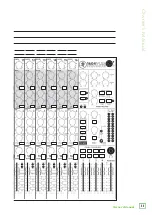
22
1604VLZ4
1604VLZ4
48. Meters
The 1604VLZ4’s peak metering system is made up of
two columns of twelve LEDs. Deceptively simple,
considering the multitude of signals that can be
monitored by it. If nothing is selected in the source [42]
matrix, and no channels are in solo [27], the meter
display will just sit there. To put them to work,
you must make a selection in the source matrix
(or engage a channel's solo switch).
Why? You want the meter display to reflect what
the engineer is listening to, and as we’ve covered, the
engineer is listening either to the control room output
or the headphones. The only difference is that while the
listening levels are controlled by the CR/phones [43]
knob, the meter display reads the source mix before
that control, giving you the real facts at all times,
even if you’re not listening at all.
When the solo mode [44] switch is set to PFL (down),
all soloed signals will be sent to the left meter only.
That, combined with the level set LED [45], are along
the path of enlightenment known as the level-setting
procedure (page 5). During AFL mode, the meters will
behave normally.
48
42
43
44
45
Meters vs. Reality
You may already be an expert at the world of “+4” (+4
dBu=1.23 V) and “–10” (–10 dBV=0.32 V) operating
levels. Basically, what makes a mixer one or the other
is the relative 0 dB VU (or 0 VU) chosen for the meter
display. A “+4” mixer, with a +4 dBu signal pouring out
the back will actually read 0 VU on its meter display.
A “–10” mixer, with a –10 dBV signal trickling out, will
read, you guessed it, 0 VU on its meter display. So when
is 0 VU actually 0 dBu? Right now!
At the risk of creating another standard, VLZ4
compact mixers address the need of both crowds
by calling things as they are: 0 dBu (0.775 V) at the
output shows as 0 VU on the meter display. What could
be easier? By the way, the most wonderful thing about
standards is that there are so many to choose from.
Thanks to the 1604VLZ4’s wide dynamic range,
you can get a good mix with peaks flashing anywhere
between –20 and +10 dB on the meter display.
Most amplifiers clip at about +10 dB, and some
recorders aren’t so forgiving either. For best real-world
results, try to keep your peaks between “0” and “+7.”
Please remember: Audio meter displays are just tools
to help assure you that your levels are “in the ballpark.”
You don’t have to stare at them (unless you want to).
If you find that staring at the meters sends you into a
hypnotic trance, please do not be alarmed. Just cut my
lawn and polish my car every Tuesday.















































